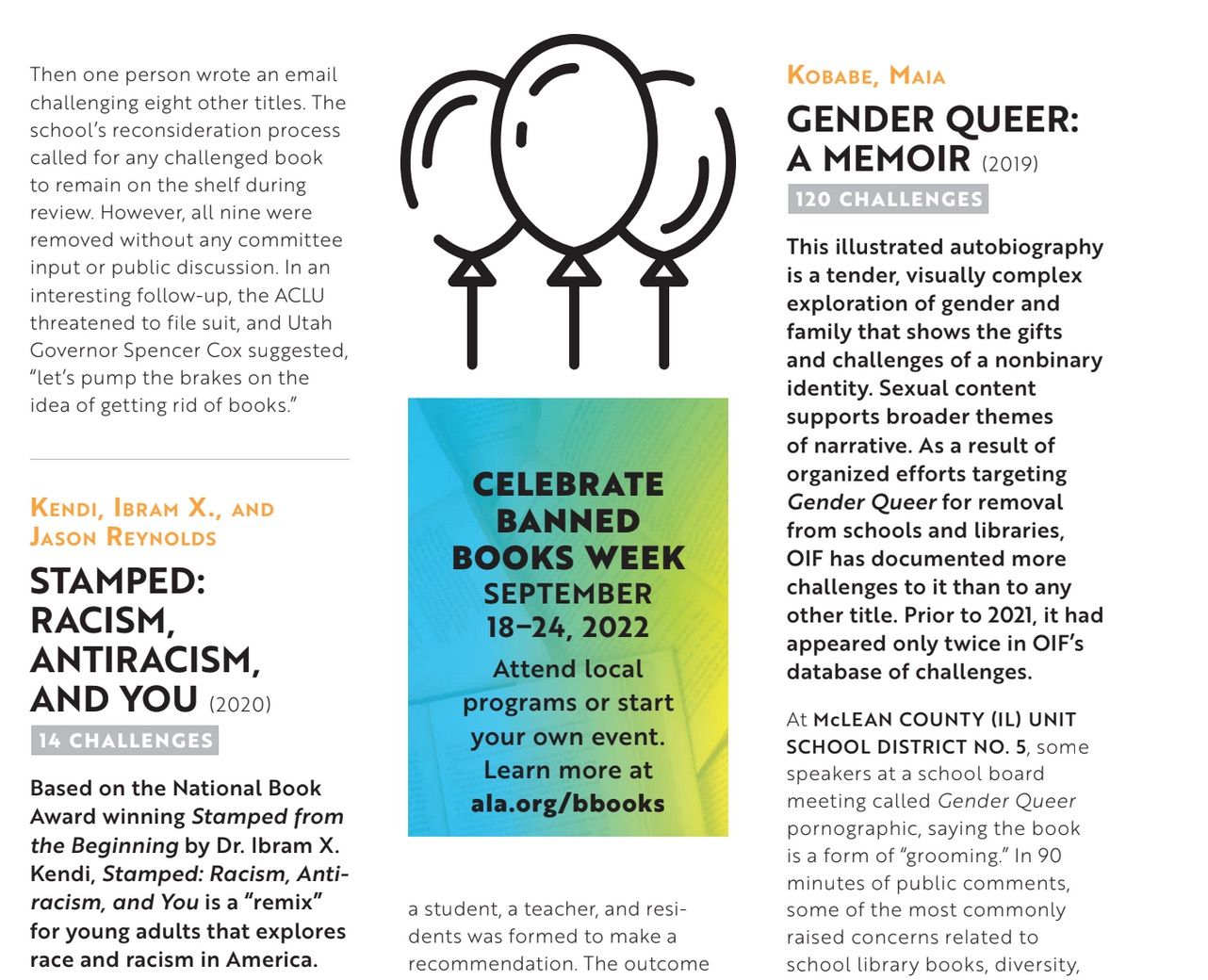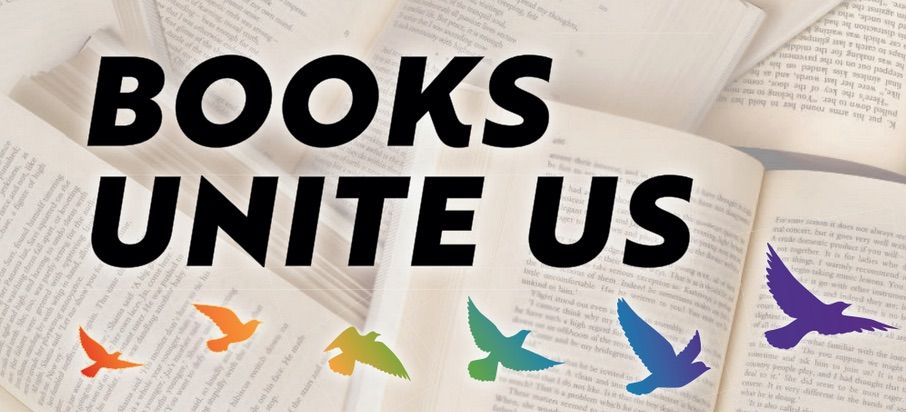Banned Books Week launches Monday, September 19, 2022, and the American Library Association (ALA) has released the latest numbers on book challenges in a new field report. Pulling from information reported directly to ALA’s Office of Intellectual Freedom (OIF), news coverage, and public records, the data show a marked increase in censorship and 2022 is on track to have the highest number of instances of book bans since ALA began keeping record.
Among the highlights of the report including:
- The challenges reported to ALA in 2021 represented the highest number of attempted book bans since ALA began compiling these lists more than 20 years ago. Eight months into 2022, book challenges are on track to exceed 2021’s count.
- 681 attempts to ban or restrict library resources in schools, universities, and public libraries, seeking to remove or restrict 1651 different titles in 2022. In 2021, there were 729 attempts to censor library resources, targeting 1597 books.
- 70% of the 681 attempts to restrict library resources targeted multiple titles. In the past, most challenges to library resources only sought to remove or restrict a single title.
- OIF documented 27 instances where police reports were filed against librarians over books on library shelves.
This new report is the first from ALA to directly address the root causes of the increase in book bans across the country. From the report:
Several related movements contributed to this surge in censor- ship. Organizations like Moms for Liberty and No Left Turn in Education provided resources including target lists, talking points, and planning documents supporting book challenges. Conservative think tanks such as the Manhattan Institute and the Heritage Foundation advanced model legislation and policies targeting “divisive concepts” and “critical race theory” in curricula and libraries. Republican PACs supported the election of pro-censorship candidates to school and library boards. Fringe ideas from MassResistance and QAnon were normalized through right-wing media outlets, politicians, and algorithmic elevation on social media sites.
It is refreshing to see the organization name some of the big players in the censorship game; unfortunately, the report still does not address where or how these groups are being funded and the direct lines from those groups to similar ones launching campaigns in ALA’s early censorship tracking years.
ALA released their top ten most challenged books for 2021 back in April. The new report adds more context to their data: examples of censorship toward several of the most challenged, alongside the number of reports indicating a title. They are as follows:
- Gender Queer by Maia Kobabe: 120 challenges
- Lawn Boy by Jonathan Evison: 67 challenges
- All Boys Aren’t Blue by George M. Johnson: 64 challenges
- Out of Darkness by Ashley Hope Perez: 36 challenges
- The Hate U Give by Angie Thomas: 32 challenges
- The Absolutely True Diary of a Part Time Indian by Sherman Alexie: 28 challenges
- The Bluest Eye by Toni Morrison: 25 challenges
- This Book is Gay by Juno Dawson: 24 challenges
- Looking for Alaska by John Green: 24 challenges
- Me and Earl and the Dying Girl by Jesse Andrews: 23 challenges
- Beyond Magenta by Susan Kuklin: 22 challenges
- Monday’s Not Coming by Tiffany D. Jackson: 22 challenges
- Drama by Raina Telgemeier: 18 challenges
- Melissa by Alex Gino: 18 challenges
- It’s Perfectly Normal by Robie Harris: 18 challenges
- Fun Home by Alison Bechdel: 16 challenges
- This One Summer by Mariko and Jillian Tamaki
- All American Boys by Jason Reynolds and Brendan Kiely: 14 challenges
- Stamped: Racism, Antiracism, and You by Jason Reynolds and Ibram X. Kendi: 14 challenges
It is crystal clear books by/about queer people and people of color continue to be targets for censorship. It is also clear that books are an easy target; these actions are meant to stir the moral panic and encourage further marginalization of these groups of people.
The new report also highlights challenges to Pride displays this year. According to their data, 27 challenges were made against such displays this year, and the report includes stories from Wisconsin, Pennsylvania, and Arkansas (though absent from the report is that coordinated efforts like Catholic Vote’s “Hide the Pride” helped spur such challenges and the disappearance of queer books from libraries).
The field report ends with a letter from James LaRue, Executive Director at Garfield County Library District (CO) and library consultant, contextualizing the why of timing:
There are two broad dimensions of this moment in time. The first is personal. As I’ve written elsewhere, historically most material challenges fall into those offered to children between the ages of 4 and 6 (picture books) and 14 and 16 (YA novels). These are times of transition in their lives, and some parents become overprotective of their children’s innocence, reflecting their own insecurities and fears. It’s an emotional reality amplified by current fears and concerns related to the pandemic.
The second is political. Many of the challenges to materials are directly linked to the talking points of today’s conservative movement. According to those leading these political movements, critical race theory (taught in no public school in the United States) is part of a “woke” and “divisive” threat, mask mandates are intolerable restrictions on personal liberty, parental rights are sacrosanct, and public institutions and credentialed experts are fundamentally suspect. One wonders if the timing of these legislative and anti-institutional efforts, especially given the dissemination of lists by politicians (such as the 850 titles disseminated by Texas state Rep. Matt Krause), isn’t primarily intended to rouse a base and win midterm elections. Informing that political push is a demographic shift. After a period marked by liberal social change—the election of a Black president, the Black Lives Matter movement, the legal and public acceptance of same-sex marriage, the greater visibility of LGBTQIA+ people—certain groups fearful of a loss of privilege and status are engaged in a moral panic.
It may also be that too much time in social isolation has made us all more stressed and less civil.
While both are true, neither goes far enough to denounce the political movement and dark money funding these initiatives. Likewise, library workers and educators are facing targeted harassment by such censors in a way that undermines their credibility and professional skills, resources, and background. This is not about social isolation nor about the age groups in question. It is about gaining power and retaining white supremacy in all facets of public life, fueled by a far-right Christian nationalist movement that has been steadily gaining traction since before the Trump administration.
The report does not touch on other censorship happening in public or school libraries related to programming, nor does it touch on the ever-growing problem of quiet/silent censorship taken in response to fear of potential challenges.
ALA’s report, while a step forward from previous public communications that shied away from naming the direct causes of the current censorship climate, still fails to account for the true breadth of books under attack. Their numbers include direct counts, as well as counts in media reports, and even a quick perusal of the weekly links here show a number much higher. And while the report offers some actions people can take to counter censorship, what they offer is nothing that is new. At times, the use of images within the report undermines the severity of the messages being conveyed:

For readers and professionals just wading into the world of book censorship, ALA’s new resource is a great place to begin. But for those looking to do more or seek real support from the organization for this ongoing and escalating reality–which includes physical threats of harm and violence to library workers on the front lines in states across the country–the report is nowhere near enough.
You can read the report in full at ALA’s Banned Books Week resource page.
